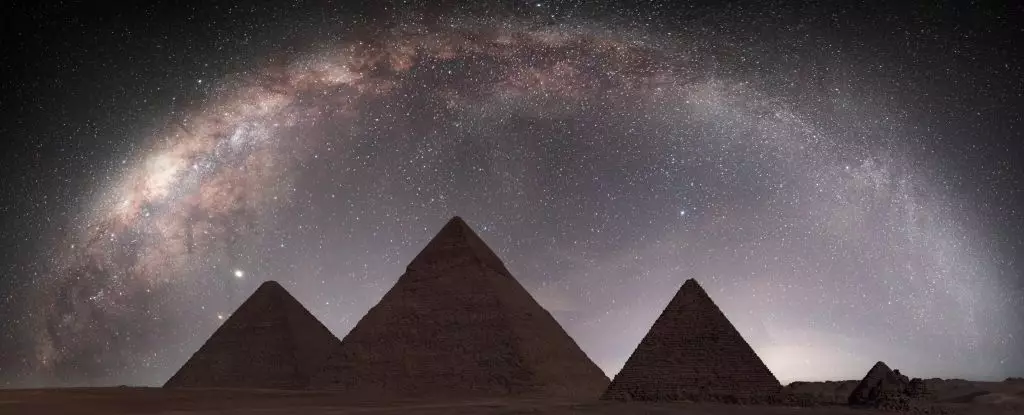In recent years, the intersection of ancient mythology and modern astronomy has sparked intriguing discussions among researchers, particularly regarding the iconic Egyptian goddess Nut. Dr. Or Graur, an astrophysicist based at the University of Portsmouth, has made compelling claims that representations of Nut may contain profound illustrations of the Milky Way, shedding light on our understanding of both ancient cultures and the cosmos. His work represents a fascinating convergence of art, history, and science, revealing how ancient civilizations interacted with celestial phenomena, as well as how modern interpretations can sometimes lead us to rediscover long-held beliefs and insights.
Nut, revered as the deity of the sky in ancient Egyptian belief, was often depicted in breathtaking forms, embellished with stars and lunar motifs. Her imagery graced tombs and coffins, signifying her critical role in the afterlife and serving as a protective figure for the deceased. Graur’s analysis posits that beneath the layers of mythology lies an actual cosmic reflection; the extensive studies of various coffins have unveiled intricate patterns that could indeed represent the Milky Way, complete with its dark bands of cosmic dust.
The Artistic Expression of the Cosmos
Graur’s investigation delves into historical artifacts, analyzing hundreds of coffins that date back thousands of years. One noteworthy finding emerged from the coffin of Nesitaudjatakhet, a vocalist dedicated to Egyptian deities Mut and Amun-Re. The illustration of Nut on her coffin features what appears to be a thick, sinuous line encircling her body, flanked by stars—a striking visual that bears a resemblance to the familiar view of the Milky Way. This undulating line could symbolize the Great Rift, the dark swath of dust that stretches across the galaxy, thereby merging artistic expression with astronomical reality.
This realization carries profound implications. It suggests that ancient Egyptians were not merely creating abstract forms but engaging in a celestial dialogue through their art. The seamless blend of spirituality and scientific awareness reflects a society deeply attuned to the wonders above, as well as their shared relationship with the universe. However, the rarity of such representations of Nut raises important questions about the perceived connections between deities and celestial phenomena in Egyptian culture.
Interdisciplinary Insights
Graur’s findings underscore the immense value of interdisciplinary research that transcends the boundaries of astronomy and Egyptology. By looking at historical art through an astrophysical lens, Graur brings forth a fresh perspective on a culture renowned for its intricate beliefs and elaborate mythologies. While Nut’s depictions are typically linked with her protective role over the deceased, Graur emphasizes that she is not merely a stand-in for the Milky Way. Instead, she represents a broader understanding of the universe that incorporates various celestial bodies into her cosmic identity.
The analysis also delves into the limitations of previous interpretations, urging scholars to connect more deeply with the artifacts of the past. Graur suggests that while Nut may not strictly embody the Milky Way, the relationship between the two signifies a nuanced understanding that combines mythology with the observable universe. The intermittent appearance of a cosmic motif in association with Nut implies a deeper dialogue within the ancient narrative that merits further exploration.
The Call for Preservation and Accessibility
An essential component of Graur’s research is the advocacy for increased accessibility to museum artifacts and archives. He emphasizes a pressing need to digitize and publicly share cultural and historical records so that scholars and enthusiasts alike can engage with ancient material in more meaningful ways. Making these resources available democratizes knowledge, encouraging collaborative endeavors that could unearth further developments in our understanding of historical influences on contemporary beliefs in science and spirituality.
By urging institutions to prioritize public access, Graur aligns with a larger trend within the academic community that emphasizes the importance of shared knowledge. In an age where technology allows for unprecedented connectivity, he highlights a fundamental truth: the more we understand and appreciate our ancient past, the more insightful our explorations into the heavens may become.
Graur’s exploration of ancient Egyptian art provides a substantial opening into how our perception of the cosmos has been shaped through cultural narratives. The impact of celestial bodies on mythology not only enriches our understanding of ancient societies but also brings us closer to realizing the interconnectedness of human experience across time and space. The Milky Way’s enduring influence on artistic expression is a testament to the timeless curiosity that propels humanity toward the stars.


Leave a Reply